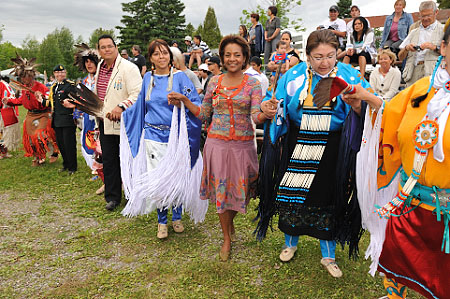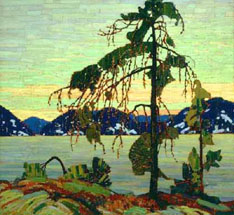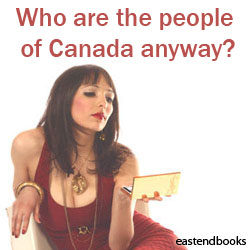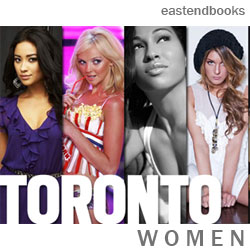Canada Day 2009 : Percy Robinson and the reluctant Canadian republic
Jun 28th, 2009 | By Counterweights Editors | Category: Canadian Republic
Celebrating the 142nd birthday of the confederation in Hogtown.
TORONTO. SUNDAY, JUNE 28, 2009. The Canada Day that looms ahead this year is looking a bit gloomy in Canada’s most populous metropolis. As just one of many cases in point, an Ontario cabinet minister from faraway Windsor has called Torontonians “babies” for complaining about a garbage strike right when the weather gets hot. Premier McGuinty himself (from Ottawa) has obtusely counseled patience. An aging local newspaper columnist more sensitively reports a “rising concern that public sector workers … can take advantage of their monopoly position to blackmail ordinary citizens … It’s hard not to feel – angrily – that something is wrong.”
The deepest background is of course the economy, stupid. Toronto today is not the economic powerhouse it used to think it was. But fresh intimations of the local past and future offer fresh glimmers of hope. It is high time that someone started celebrating the remarkable local historian Percy Robinson, author of the minor classic of 1933, Toronto during the French Regime. And then there are the growing republican urges of this once very Tory monarchist town. (As in Frederick Vaughan’s book of 2003, The Canadian Federalist Experiment: From Defiant Monarchy to Reluctant Republic.) In any case, Happy Canada Day Canada – from the big city region you love to hate. The times are changing. Many new answers are blowing in the wind.
1. Percy James Robinson, 1873-1953: Classicist, artist, teacher, historian …

Worrying about economic development in Canada's most populous province.
As just one measure of the region’s participation in the current global economic malaise, the May 2009 unemployment rate in the Toronto census metropolitan area was 9.3%, up from 6.6% in May 2008 (and compared, e.g., with May 2009 rates of 6.3% in Halifax, 6.7% in Calgary, and 7.0% in Vancouver).
Toronto is nowadays much closer in this respect to its old rival Montreal (with a May 2009 unemployment rate of 9.7%). And this leads logically enough to some Canada Day reflections on the career of the Percy Robinson who first published Toronto during the French Regime in 1933.
1.1 In a state of near amnesia
Percy James Robinson was born in Whitby, Ontario – east of Toronto proper, then and now – in 1873, just a half dozen years after the Canadian confederation of 1867, and an entire 50 years before the book for which he is best known among at least a few fellow labourers in neighbouring vineyards was first published.
As Germaine Warkentin has nicely put it, for “a large part of its history, Toronto has been in a state of near-amnesia, seeking desperately for its own memory.” A city that had a better sense of its own memory would also have a better memory of Percy Robinson. (As matters stand, e.g., there is a Wikipedia article on his son, Gilbert de Beauregard Robinson, who became an eminent mathematician at the University of Toronto, but no such article on Percy himself, even though: “Scholars are familiar with Percy Robinson’s Toronto during the French Regime, 1615-1793.”)
1.2 Percy at St. Andrews College

Percy Robinson taught Latin at St. Andrew's College for 48 years.
Part of Percy Robinson’s continuing obscurity may be that he is an ironic figure, with one foot firmly planted in Toronto’s 19th century British North American past, and the other in a more exotic 21st century future he only half perceived – and perhaps one-quarter understood. (Which still makes him more interesting than the rest of us, even on Canada Day 2009.)
By the early 20th century Percy (if you know his writing well it seems right to use his first name) was living in Toronto and teaching Latin at St. Andrew’s College – a local private institution modeled on the British public schools, where the men who ran the greatest empire since Rome, on which the sun never dared to set, etc, received their early education. Toronto in the first half of the 20th century, as Percy explained at the end of his book of 1933, was “the citadel of British sentiment in America, and Ontario, the most British of all the provinces” in Canada.

Percy Robinson died before the current Canadian flag was born. But it seems a good guess that he would have been proud of it.
St. Andrew’s College was and still is “a boys’ independent school (grades 6-12) located in Aurora, Ontario, Canada, founded in 1899. It is a university-preparatory school, with a focus on academic achievement, athletics, and leadership development … First situated in Toronto on land east of Old Yonge Street over to Bayview Avenue [now suburban York Mills],” the school “moved north to its current campus in Aurora in 1924.” (Just in case you’re wondering, it costs about $40,000 per year to send your son there as a boarding pupil nowadays.)
One item that is on the Internet at the moment sheds some light on both Percy’s character, and his long career as a teacher at St. Andrew’s. It is an article entitled “The First World War & St. Andrew’s College.” It originally appeared in “the St. Andrew’s College Review, June 1919 Memorial Issue and was written by Percy J. Robinson who was one of the first masters at the school and stayed for 48 years.”
Like almost everything else Percy wrote, this article has its interest, even if you don’t at first warm to the subject. Canadians made stupendous sacrifices during the First World War. And you can see this in the story Percy tells (despite its sometimes now archaic turns of phrase).
To take just one example: “the year 1917 was full of glory to Canada, and how often was the school to feel just pride in the performance of her Old Boys. They were to be found in every theater of the conflict, playing the watch-dog game in the Channel, doing bacteriological work in Mesopotamia [nowadays of course called Iraq], fighting the typhus among the Chinese coolies, driving an ambulance in Italy, and in the forefront of every battle. Quae regio in terris nostri non plena laboris … Canada on the fiftieth anniversary of Confederation was crowned with sorrow and glory by the sacrifices of her sons.”
1.3 Percy and the Group of Seven

In 1981, some 28 years after Percy’s death, his eminent mathematician son, Gilbert de Beauregard Robinson, published a short commemorative biographical sketch of his father, entitled Percy James Robinson, 1873-1953, classicist, artist, teacher, historian. As this title suggests, along with his day job teaching Latin (and Greek?) at St. Andrew’s College, Percy was also an artist who painted in oil. He shared the enthusiasm of his local contemporaries for bringing the unique mysteries of the northern North American wilderness to life. And he was invited to contribute to the Group of Seven‘s third exhibition at the Art Gallery of Toronto (now the Art Gallery of Ontario) in May 1922.
Another related item on the Internet at the moment is a short article by Percy on “The Group of Seven.” It appeared in the January 1923 issue of Acta Victoriana – a publication of Victoria College at the University of Toronto. It may not be great art criticism. But it is a lively attempt to explain just what the Group of Seven was doing to the fine art patrons of Toronto in the 1920s (among whom, as Percy put it rather abruptly, “so very rarely are pictures chosen for a house with as much taste as wall paper and carpets”). Most members of the Group of Seven had their own day jobs as commercial artists. Nonetheless, Percy went on, for “the time being” they were also “experimenting within the range of certain methods which seem specially adapted to interpret the most typical Canadian scenery to Canadians in an original and forceful manner.”
1.4 The first historian of early modern Toronto
However he may have fared in his own time as a “classicist, artist, and teacher,” it is as an original and forceful historian of Toronto that Percy James Robinson is still best remembered nowadays, among those who do remember him. His not altogether perfect but still compelling masterpiece is the Toronto during the French Regime which was first published in 1933, and then republished in 1965 – at another moment when Toronto, in a state of near-amnesia, was desperately seeking its own memory.
There appear to be several motivations behind Percy’s interest in what is now more widely recognized as the earliest era in the history of modern Toronto (1615-1793). To start with, he had married a vaguely French young lady called Esther Toutant de Beauregard, who was among the earlier women to graduate with a BA from the University of Toronto. (In her case in 1894; Percy himself, it seems, graduated from the same institution in 1896.)
Another apparent ingredient was that between the two world wars Toronto was not the largest metropolis in Canada as it is today. It was still playing second fiddle to the original great Canadian metropolitan centre in Montreal – ancient capital of the northern North American fur trade that had spread from coast to coast to coast via the aboriginal transportation technology of canoe and portage, and headquarters of the modern Canadian transcontinental railway system. As Percy put it in the preface to his book of 1933: “Younger by two hundred years than Montreal and Quebec, Toronto, at first sight does not seem to possess that heritage of history and romance which flings a glamour about the traditions of the older cities.”
In Toronto during the French Regime Percy, as it were, was trying to show that in fact modern Toronto’s history was almost as old as that of Montreal and Quebec. For “a century and a half before the arrival” of the first British governor of Upper Canada, John Graves Simcoe, Toronto had “a history which, though little known, is always dramatic and picturesque.”
It may be as well that what Percy Robinson was most dramatically trying to show here had a lot to do with the rising commercial aspirations of Toronto – and with the then-in-sight culmination of the city’s long hunger to replace Montreal as the great Canadian metropolitan centre. And it may equally be that one of the reasons for Percy’s continuing relative obscurity today is that he never quite succeeded in this task. He would, so to speak, finally confess his failure, in an article he published in the Canadian Historical Review in January 1943, called “Yonge Street and the North West Company.”
(And the ultimate problem here, it may be clearer on Canada Day 2009, is that while Toronto finally did supplant Montreal as Canada’s most populous metropolis in the census of 1976, this only showed that there was no longer any single great metropolitan centre in Canada. Toronto could not supplant Montreal in this respect, because the status itself had been rendered obsolete by Toronto’s own success. And the growth of such still more westerly places as Calgary and Vancouver only confirms the point today.)
From another quite crucial angle, however, Toronto during the French Regime lives on in the early 21st century, because it continues to provide our first realistic glimpses of the earliest history of the modern Toronto that has blossomed into its most authentic and independent permutation in the most recent past.
And, for better or worse, Percy’s story is not about the growth of some rising new francophone culture on the northwestern shore of Lake Ontario. Toronto during the French regime, in the 17th and earlier 18th centuries, was not a French place, in any serious sense. It was, as Percy’s book of 1933 still shows so intriguingly, “French and Indian” – or even European-and-Indian-multicultural. It had an exotic quality that has at last begun to mature and come into its own in the early 21st century.
Percy Robinson, that is to say, wittingly or otherwise, and ironically enough in some respects, was the first historian of early Canadian multiculturalism in the Toronto region. In this respect his work is more interesting now than it has ever been before. And the early multicultural development he describes is far from unique to Toronto. It is a growing and very traditional part of Canada, in both official languages, and from coast to coast to coast.
So on Canada Day 2009 we will be raising our glasses of locally brewed whatever to Percy James Robinson, 1873-1953: Classicist, artist, teacher, historian. As best as we can make out, at any rate, he is one of the old but still fresh and new answers nowadays blowing in the wind. When the going gets tough, the tough get going. And as Toronto during the French Regime shows, from its earliest modern beginnings Canada has always been, whatever else, a very tough place.
2. The increasingly undeniable logic of the reluctant Canadian republic …

Toronto at night, in the early 21st century.
Whatever else, Toronto (and Ontario) today are certainly no longer what Percy Robinson said they were in 1933 – “the citadel of British sentiment in America, and Ontario, the most British of all the provinces.”
In February 2008, e.g., Angus Reid Strategies asked a representative sample of Canadians: “Under the terms of the Canadian Constitution, Queen Elizabeth II holds the position of Canada’s head of state. Would you support or oppose Canada ending its formal ties to the British monarchy?” Ontario had the highest percentage of respondents supporting this proposition (54%) of all provinces except Quebec (71%).
You might reasonably guess as well that if separate numbers for this statistic were broken out for Toronto, the percentage that supported “Canada ending its formal ties to the British monarchy” would be rather higher than 54%. And, on some somewhat similar plane of being, the Percy Robinson who married Esther Toutant de Beauregard and wrote Toronto during the French Regime might have smiled a little if he had been watching last night’s Medeski Martin and Wood concert at the TD Canada Trust Toronto Jazz Festival.
The group originated in Brooklyn, NY in 1991 and is still based in the USA. At the end of its June 27, 2009 performance drummer Billy Martin told a wildly enthusiastic Toronto crowd “Thank you, merci beaucoup.” (He might have thought he was in Montreal. It reminded some of us of the baseball player from Ohio David Justice, who once said he couldn’t live in Toronto because he didn’t speak French.)
2.1 Then and now … Sir John Beverly Robinson … and Lawrence Martin’s lament
Toronto nowadays is also home base for the largest Canadian republican advocacy group – a fact which may make the ghost of another local Robinson (Sir John Beverly, 1st Baronet, of Toronto, from an old Virginia loyalist family) turn in his grave.
It is similarly interesting that in his Canada Day column for this year Lawrence Martin of the Toronto Globe and Mail complains about “Canada’s insistence, as some critics remind us, on remaining mired in a colonial mindset. We can’t shake the pulls of the past. It’s 2009. It’s birthday No. 142. Canada Day shouldn’t feel like Colony Day. But you could be forgiven for having that impression.”
Mr. Martin also feels that no real progress is being made on “oh yes, the monarchy. There were some who thought that, by this time, Canadians would be taking at least baby steps toward a final break with our original colonial master.”
Well, as Percy might point out, our original Canadian colonial master was a French not a British monarch, but not to worry. Despite the news that Prince Charles and Camilla will be visiting this fall, in a vain attempt to shore up support for his eventual succession as King of Canada, you don’t have to be a political rocket scientist to appreciate that the British monarchy in Canada is now on its very last legs.
2.2 The writing on the wall for the British monarchy in Canada today

The Annual Caribana parade in Toronto today
At the moment, there are apparently assorted nattering nabobs of the 19th century plotting some bizarre final defence from the crumbling ramparts of the long lost empire. As the Angus Reid opinion polls suggest, they are only clarifying the desperation of their cause.
At the same time, there is no doubt much confusion about the past and the future on Canada Day 2009 – in Toronto and most other parts of the country. (Just consider the latest musings of Pauline Maurois in Quebec, e.g.) There are those who at least pretend to warmly agree that Canada must soon end its formal ties to the British monarchy. And then quickly add “but we certainly don’t want to become a republic.”
Our initial reaction to all this is just so don’t call it a republic. And if some democratized version of the current office of Governor General is going to become the new independent Canadian head of state, in law as well as fact (as it virtually is already – and we do agree that this is what should happen), and if the majority of Canadians don’t want to call this new head of state a president (as in India or Ireland or many other such places that have the same British-style parliamentary democratic government as Canada), then our view is fine, call it something else.
(Or just keep the perfectly sensible term Governor General, which arguably goes all the way back to Samuel de Champlain in the early 17th century. Or how about “Onontio” – which was the old aboriginal name for the French Governor at Quebec City?)
2.3 Getting to the bottom of our irrational fears

Frederick Vaughan's 2003 book on the long Canadian journey from "defiant monarchy to reluctant republic."
And yet there seems something almost psychotic, or quite neurotic, or sociopathic, or at least misguided about all this. We finally think that we Canadians owe it to ourselves to get to the bottom of our irrational fears of the terms “republic” and “republican.” We – or too many among us at any rate – view these words with a unique scepticism in the global village, and it just makes us seem quaint and unworldly (and/or plain out to lunch).
The crux of the matter may be nicely summarized in the title of a book published in 2003 by Frederick Vaughan, a retired professor of political science from the University of Guelph – at the exurban edge of the Toronto city region. It’s called The Canadian Federalist Experiment: From Defiant Monarchy to Reluctant Republic.
The Canadian confederation of 1867, Mr. Vaughan notes, began as a theoretically quite centralized “monarchic federation,” as well as a still not quite democratic parliamentary government (with, as George Brown complained in a letter to his wife, a lamentably “tory constitution”). Then things began to change. To start with, there were the decentralizing constitutional decisions of the British Judicial Committee of the Privy Council – the highest court of appeal for Canada until 1949. Then there were many other things, finally culminating with Pierre Trudeau’s remarkable Constitution Act 1982, which “was the instrument that” ultimately “severed Canadians from their ancestral monarchical foundations” for all time.
So Mr. Vaughan carries on: with the new Canadian Charter of Rights and Freedoms that formed the at last impressive, independent legal backbone of the Constitution Act 1982, “Canada began a new life as a nation, a republican nation. The Charter is based upon republican principles. It is the closest Canadians have ever come to a document that affirms the rights of the people.”
2.4 A Canada Day beverage … to Our Canadian Republic …

Canada Day in Calgary ... a long way from Toronto but still the same big country.
Why then is Canada still what Frederick Vaughan’s title calls a “reluctant republic”? (Or why, for that matter, does the British monarch officially remain Canada’s formal head of state?) There are no doubt many subtle reasons for all this. And on Canada Day 2009 they probably deserve extended public debate and discussion – in an authentic replica of a cantankerous 19th century Canadian tavern, at some dusty concession crossroads in rural Ontario, or Nova Scotia, Quebec, Alberta, British Columbia, Nunavut and beyond.
But the simplest and most obvious reason for republican reluctance in Canada today is the ancient British North American monarchist tory legend (not to more frankly say plain political lie) that the only way Canada can really become a republic is to join the United States. And what serious Canadian wants to do that, even in the Barack Obama age of wonders?
Yet the more cosmopolitan truth of the matter in the real global village is that there are many different kinds of republics in the world today, and the United States is only one of them. If Canada is not going to have the British monarch as its head of state any longer, it is going to become some form of republic, as words are ordinarily used by everyone else in the rest of the world. In the very end it is only our timid childish fears of being swallowed alive by the elephant next door that make us so reluctant to conceive of any kind of Canadian republic.
At the same time again, on Canada Day 2009 there are some happy reasons for hope on this front. Note, e.g., the November 2008 article “Our Canadian Republic” in the Literary Review of Canada, by the “writer in Toronto, and the author of 1867: How the Fathers Made a Deal,” Christopher Moore. And remember the meeting at Metro Hall in Toronto this past still-so-called Victoria Day holiday, on “Canada after the Queen: Options and opportunities …Â ending the monarchy and what Canada should be doing to prepare for a republic.”

Governor General Jean with some aboriginal peoples of Canada today.
As best we can make out, in any case, if the Percy James Robinson who wrote Toronto during the French Regime were still alive today, he would have more than a little sympathy for the present-day Canadian historian Michael Behiels’s 2005 review of Frederick Vaughan’s The Canadian Federalist Experiment: From Defiant Monarchy to Reluctant Republic: “Vaughan does not lament the decline of the ‘defiant monarchy,’ nor does he call for the weakening of the Charter by placing overly ideological containment measures on Canada’s Supreme Court justices. Instead, he counsels Canadians to understand how and why the decline occurred and encourages them to design and embrace a truly distinctive and bold Canadian republic.”
So … the customary practical political rhetoric of course is still that, however logical it may certainly be, all this is not all that important and certainly far from urgent. Canadians are better occupied worrying about a single securities regulator for Canada – and other such more down-to-earth issues of the day in the nightmare old lumber village of Ottawa, on the ancient troubled border between Ontario and Quebec. But if any of it means anything to you at all, regardless of where you live in the potentially near-great northern North American country of the future, on Canada Day 2009 you could briefly raise a glass of some kind of beverage (as the Brits still say) to what Christopher Moore has now so alluringly called “Our Canadian Republic”!



very interesting…learned a few things I never knew about my Great Grandfather, Percy James Robinson…thank you…
https://www.facebook.com/media/set/?set=a.76647910248.140485.585565248&type=3 family photos of Percy James Robinson